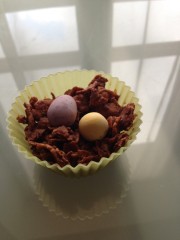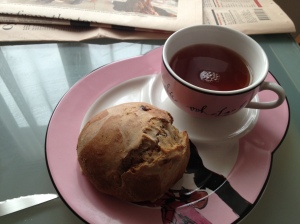Hope the Easter bunny visited you all!
I got a lovely bag from my mum full of goodies, including Creme Eggs, a Cadbury Buttons egg, and a Lindt bunny (although I didn’t buy any little ones this year to bow down to it).
I also got some of these:

which I used to make these:
Definitely one of the easier treats out there and easily one of the most satisfying too. I used a proportion of 60g of cereal to 100g chocolate, but the beauty of this recipe is in its flexibility: you can use any plain cereal you like (rice krispies, cornflakes, bran flakes…) and any type of chocolate (although milk chocolate is the most commonly used in this recipe), and of course it stands up well to increases in the chocolate proportions too :p All you have to do is mix the melted chocolate with the cereal, spoon it into cake cases, shove in 2-3 mini eggs, and then put into the fridge!
I definitely like the symbolism that Easter treats provide: the eggs and nest above are great for reinforcing the “new life” theme, and Easter eggs themselves symbolise not only this, but also are supposed to symbolise the empty tomb of Jesus and his resurrection. (Hence why Easter eggs are not actually supposed to come with things inside them.)
I also made some other treats this season with explicitly religious connotations. One of them was a simnel cake, of which you get a generic picture, since I can’t find the one I took (boo):

The issue of how many marzipan balls you are supposed to include is a point of contention for many bakists. Many simnel cakes have one marzipan ball in the middle to represent Jesus, so then you have to dither over how many “disciples” you will have around the outside edge. You can either have 11 around the outside edge and Jesus in the middle, or 12 around the outside edge with Jesus included (noting that you obviously exclude Judas both times). While fruit cakes are popular throughout English culinary tradition, the nice thing about the simnel cake is that it’s lighter than many of these (such as the Christmas cake), perhaps due to the fact that it does without the long period of being fed with alcohol (which would make sense given the traditional austerity of Lent). Plus, the addition of spices makes it more Germanic, thus differentiating it slightly from other English fruit cakes.
I also made hot cross buns this year, aiming to ape Heston Blumenthal’s mandarin and Earl Grey version:
(You can’t really see the cross brilliantly, but if you look closely, it is there.)
My Heston experiment did not really work, for the reasons that:
a) Orange essence is really not a strong enough substitute for real mandarin zest
b) Closer scrutiny of the ingredients of the Heston buns reveals that I should have added orange juice as well
c) Closer scrutiny of the ingredients of the Heston buns, and the recommendation of a friend, also suggests that I should have soaked the raisins in Earl Grey for much longer
and d) I shouldn’t have bothered to add Earl Grey liquid to the bun mixture, as all this did was to make the bun a browner colour.
None of this is to say that my hot cross buns didn’t taste nice, but I clearly still need to tinker with my recipe if I want to imitate Heston’s efforts fully.
The cross on the hot cross buns, of course, symbolises Jesus’ crucifixion, and even though I am no longer religious, I think it’s nice to have these subtle reminders of how these festivals (and indeed festival foods!) originated (although interestingly, in the case of the hot cross buns, pagans originally used the cross on these cakes to symbolise the four quarters of the moon).
However, I’m still on the lookout for new Easter foods to try, such as Fastelanvsboller, or Shrovetide buns, which are eaten in Norway and are flavoured with cardamom and almonds.
More difficult to recreate, though, could be these marshmallow bunnies:

(reminiscent of a late 1990s Easter spent in the US)
…and, of course, this bad boy, as publicised by Pimp That Snack:

Hoppy bloomin Easter indeed. Now to finish my headless Lindt bunny…


oooh FLORIDA & marshellow bunnies, happy times. x
Glad you enjoyed your bag of goodies xx
opps marshmellow!!
Glad you enjoyed the headless Bunny.
[…] candied ginger (for colds!) and their 1kg buckets of assorted candied fruit, for baking purposes. Simnel cake, here we […]